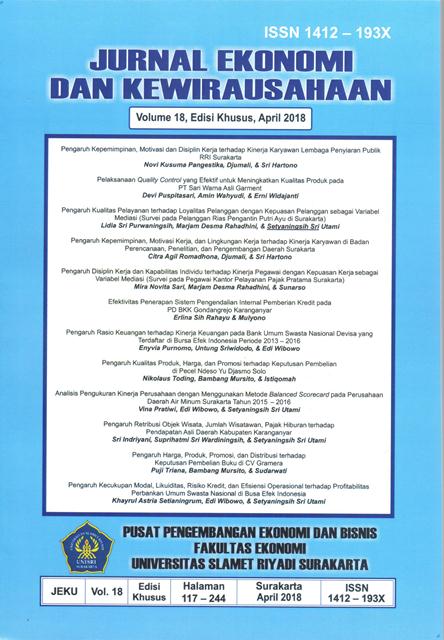PENGARUH KECUKUPAN MODAL, LIKUIDITAS, RISIKO KREDIT, DAN EFISIENSI OPERASIONAL TERHADAP PROFITABILITAS PERBANKAN UMUM SWASTA NASIONAL DI BUSA EFEK INDONESIA
Abstract
The purpose of this study is to: 1) analyze the significance of the influence of capital adequacy to profitability, 2) to analyze the significance of the effect of liquidity on profitability, 3) to analyze the significance of the effect of credit risk on profitability, 4) to analyze the significance of the effect of operational efficiency level on profitability, significance of capital adequacy, liquidity, credit risk, and operational efficiency simultaneously to profitability. This type of research use survey, data analysis technique using multiple linear regression analysis with sample of 8 bank with purposive sampling method. Hypothesis testing using t test (partial test), F test (simultaneous test), and test of coefficient of determination (R2). The result of t analysis shows that partially CAR, LDR, and NPL variables have no significant effect on ROA, while BOPO variable has significant effect on ROA. Simultaneously capital adequacy, liquidity, credit risk, and operational efficiency affect the ROA of National Private Private Banking at BEI. The result of (R2) shows that 93,7% variation of profitability variable can be explained by BOPO.Keywords: capital adequacy, liquidity, credit risk, operational efficiency, profitability
Downloads
Published
2018-12-04
Issue
Section
Artikel
License
Authors who publish this journal agree to the following terms:
- Authors retain copyright and grant the journal right of first publication with the work simultaneously licensed under a Creative Commons Attribution License that allows others to share the work with an acknowledgement of the work's authorship and initial publication in this journal.
- Authors can separately make additional contractual arrangements for non-exclusive distribution published by the journal (e.g., publish it in a book), with an acknowledgement of its initial publication in this journal.
- Authors are allowed and encouraged to send their work via online (e.g., in the institutional repositories or their website) after published by the journal.









